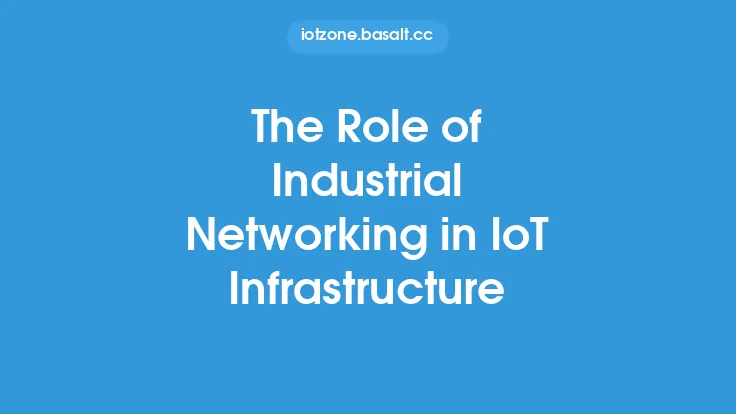The increasing demand for reliable and efficient data transfer in industrial settings has led to the development of industrial networking solutions. These solutions are designed to provide fast, secure, and reliable data transfer between devices and systems in industrial environments. Industrial networking is a critical component of the Industrial Internet of Things (IIoT), enabling the connection of devices, machines, and systems to facilitate real-time data exchange, improved productivity, and enhanced decision-making.
Key Components of Industrial Networking
Industrial networking involves several key components, including devices, protocols, and infrastructure. Devices such as sensors, actuators, and controllers are connected to the network, allowing for the collection and transmission of data. Protocols such as EtherNet/IP, Profinet, and Modbus TCP/IP are used to facilitate communication between devices, while infrastructure such as switches, routers, and gateways provide the backbone for data transfer. The choice of components depends on the specific requirements of the industrial application, including the type of data being transferred, the distance between devices, and the level of security required.
Network Topologies and Architectures
Industrial networks can be configured in various topologies, including star, ring, and mesh architectures. Star topologies are commonly used in industrial settings, where devices are connected to a central switch or hub. Ring topologies are used in applications where high availability and redundancy are required, such as in power generation and distribution systems. Mesh topologies are used in applications where devices need to communicate with each other directly, such as in wireless sensor networks. The choice of network topology and architecture depends on the specific requirements of the industrial application, including the number of devices, the distance between devices, and the level of redundancy required.
Industrial Networking Technologies
Several technologies are used in industrial networking, including Ethernet, Wi-Fi, and cellular networks. Ethernet is a widely used technology in industrial settings, providing fast and reliable data transfer over copper or fiber optic cables. Wi-Fi is used in applications where wireless connectivity is required, such as in mobile devices or in areas where cabling is not feasible. Cellular networks are used in applications where wide-area connectivity is required, such as in remote monitoring and control systems. Other technologies, such as Bluetooth and Zigbee, are used in specific industrial applications, such as in device pairing and low-power wireless communication.
Data Transfer and Communication Protocols
Industrial networking involves the use of various data transfer and communication protocols, including TCP/IP, UDP, and HTTP. These protocols provide a standardized way of communicating between devices and systems, enabling the exchange of data and control commands. Other protocols, such as OPC UA and MQTT, are used in specific industrial applications, such as in process control and industrial automation. The choice of protocol depends on the specific requirements of the industrial application, including the type of data being transferred, the level of security required, and the need for real-time communication.
Security Considerations
Industrial networking involves several security considerations, including the protection of data, devices, and systems from unauthorized access and malicious attacks. Security measures such as firewalls, intrusion detection systems, and encryption are used to protect industrial networks from cyber threats. Other security measures, such as access control and authentication, are used to ensure that only authorized personnel have access to industrial networks and devices. The importance of security in industrial networking cannot be overstated, as a breach in security can have serious consequences, including downtime, data loss, and damage to equipment and personnel.
Reliability and Redundancy
Industrial networking requires high levels of reliability and redundancy, particularly in applications where downtime can have serious consequences, such as in power generation and distribution systems. Reliability is achieved through the use of high-quality components, regular maintenance, and testing. Redundancy is achieved through the use of duplicate systems, devices, and communication paths, ensuring that data transfer and communication are maintained even in the event of a failure. Other techniques, such as error correction and detection, are used to ensure that data is transmitted accurately and reliably.
Real-World Applications
Industrial networking has numerous real-world applications, including process control, industrial automation, and remote monitoring and control. In process control, industrial networking is used to connect devices and systems, enabling real-time data exchange and control. In industrial automation, industrial networking is used to connect machines and devices, enabling automated production and manufacturing. In remote monitoring and control, industrial networking is used to connect devices and systems, enabling remote access and control. Other applications, such as in transportation systems, building automation, and smart grids, also rely on industrial networking for reliable and efficient data transfer.
Future Developments and Trends
The future of industrial networking is expected to be shaped by several developments and trends, including the increasing use of wireless technologies, the adoption of cloud computing and big data analytics, and the growing importance of security and reliability. The use of wireless technologies, such as 5G and Wi-Fi 6, is expected to increase, enabling faster and more reliable data transfer. The adoption of cloud computing and big data analytics is expected to increase, enabling the analysis of large amounts of data and the provision of real-time insights. The growing importance of security and reliability is expected to drive the development of new security measures and redundancy techniques, ensuring that industrial networks and devices are protected from cyber threats and downtime.





